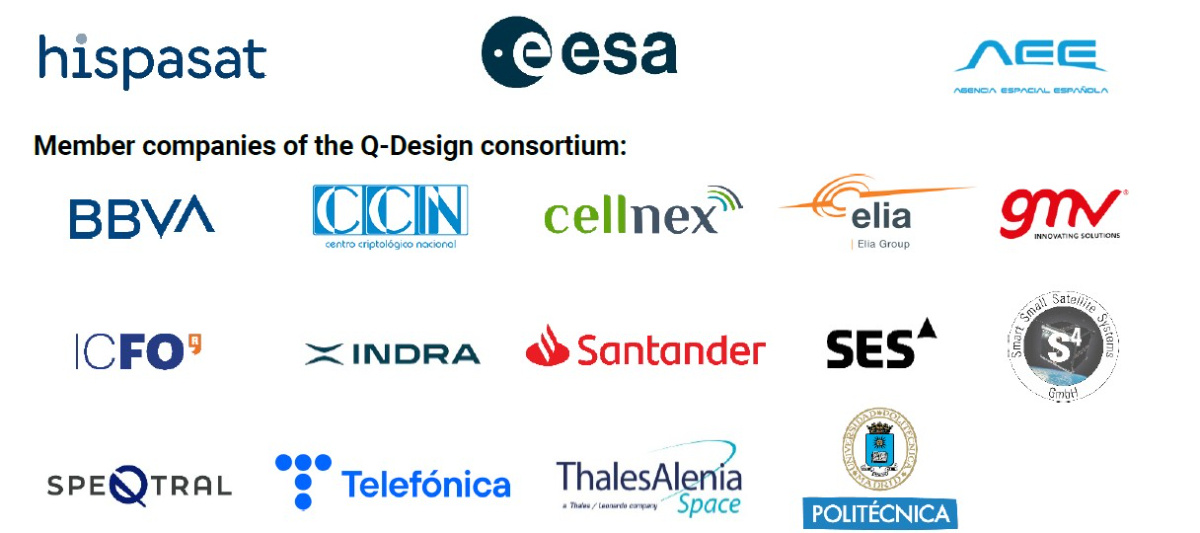June 18, 2025
Q-Design is made up of a consortium of 15 companies and organizations that will be responsible for developing this pioneering project and designing services that provide value to the end user.
The European Space Agency (ESA) has announced an agreement with Hispasat for the development of the initial phase of Q-Design, the first project worldwide to combine Quantum Key Distribution (QKD) through geostationary and low orbit satellites and terrestrial infrastructure. In this way, Q-Design will enable the design of QKD services in which users can securely exchange keys through any of these channels, depending on the conditions required at any given time. This initial phase will be dedicated to performing a feasibility study for the space segment and ground segment components required to provide QKD services using GEO and LEO orbits, in close collaboration with end users/customers and to evaluate the integration with QKD ground networks. The agreement between ESA’s Directorate of Connectivity and Secure Communications, and Hispasat was signed today during the International Paris Air Show at Le Bourget.
To carry out this project Hispasat has set up a consortium of companies and organizations covering the whole value chain that will contribute their know-how to the development of a system offering a service of high technological value. Specifically, the consortium includes research organizations: ICFO-The Institute of Photonic Sciences and the Universidad Politécnica de Madrid; manufacturers: GMV, Indra and Thales Alenia Space; satellite based QKD service providers: SES, through its EAGLE-1 system, the most advanced European LEO QKD, S4 and SpeQtral; certifying organization: Centro Criptológico Nacional del Centro Nacional de Inteligencia (CCN-CNI); infrastructure operator: Cellnex and network operator: Telefónica; financial entities: BBVA and Santander; and critical infrastructures: Elia. The next phase of Q-Design will be financed by the Agencia Espacial Española (AEE) under an ARTES-4S programme and will be dedicated to the integration of GEO and LEO QKD systems and its interfaces with terrestrial networks.
The emergence of quantum computers provides much greater computational power than traditional computers for certain mathematical problems, such as the prime factor decomposition on which current non-symmetric cryptography is based. This means a paradigm shift in secure communications, as it will be able to decrypt current encryption in a matter of seconds. It is therefore essential to develop a system that allows information to be sent with the necessary guarantees in government communications environments, critical infrastructure management and applications and services of economic, environmental or technological interest, as well as in large corporations. This technology is also a first step towards a future quantum internet, which will represent a radical leap forward in global communications.
The distribution of quantum keys through an optical communications system makes it possible to check with certainty whether they have been intercepted, since their integrity is continuously verified thanks to the quantum properties of photons. Terrestrial networks based on optical fiber are the ideal infrastructure for distances of less than a few hundred kilometers, but beyond that they suffer from signal loss. Therefore, QKD satellite systems, both in geostationary orbit and low orbit, are ideal for covering long distances. From 2028, Q-Design will offer users of this type of solution a versatile and transparent tool, adaptable to each specific need. The GEO component is a new development. The LEO component will be provided through agreement with existing infrastructure and service operators.
Laurent Jaffart, ESA Director of Connectivity and Secure Communications, said: “The Q-Design project represents a significant step towards boosting European leadership and autonomy in quantum technology and secure communications from space. ESA is proud to partner with Hispasat in the development of QKD satellite systems to ensure fast and secure communications for Europe, while fostering innovation and competitiveness within the European space industry.”
Miguel Ángel Panduro, CEO of Hispasat, added that "our company has been working for years on the development of the first geostationary quantum key distribution mission and now, with the leadership of the Q-Design consortium and the support of ESA, we are taking a new leap and placing ourselves at the forefront of secure communications."

The European Space Agency (ESA) provides Europe’s gateway to space.
ESA is an intergovernmental organisation, created in 1975, with the mission to shape the development of Europe’s space capability and ensure that investment in space delivers benefits to the citizens of Europe and the world.
ESA has 23 Member States: Austria, Belgium, the Czech Republic, Denmark, Estonia, Finland, France, Germany, Greece, Hungary, Ireland, Italy, Luxembourg, the Netherlands, Norway, Poland, Portugal, Romania, Slovenia, Spain, Sweden, Switzerland and the United Kingdom. Latvia, Lithuania and Slovakia are Associate Members.
ESA has established formal cooperation with four Member States of the EU. Canada takes part in some ESA programmes under a Cooperation Agreement.
By coordinating the financial and intellectual resources of its members, ESA can undertake programmes and activities far beyond the scope of any single European country. It is working in particular with the EU on implementing the Galileo and Copernicus programmes as well as with Eumetsat for the development of meteorological missions.
Learn more about ESA at www.esa.int
Since its origin, Hispasat is the main driver of the Spanish aerospace sector and works with the aim of helping citizens to solve the difficulties of broadband Internet connection to overcome the digital divide and promote sustainable development of society. It is a communications bridge between Europe and America as a provider of broadband and connectivity services. It is also a leader in the broadcasting and distribution of audiovisual content in Spanish and Portuguese.
Press contact:
Víctor Inchausti - tel. +34 667 31 29 48 – vinchausti@hispasat.com
Mar Díaz Varela - tel. +34 659 44 18 10 - mdiazvarela@hispasat.com